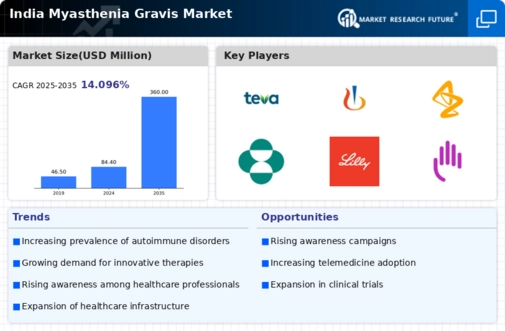Innovative Drug Development
The myasthenia gravis market is significantly influenced by the ongoing innovative drug development initiatives in India. Pharmaceutical companies are increasingly investing in research and development to create novel therapies that target the underlying mechanisms of the disease. For instance, the introduction of monoclonal antibodies and other biologics has shown promise in clinical trials, potentially improving patient outcomes. The Indian pharmaceutical sector is known for its cost-effective drug manufacturing capabilities, which may lead to affordable treatment options for patients. As new therapies enter the market, they are likely to enhance the treatment landscape for myasthenia gravis, thereby attracting more patients and healthcare providers. This innovation-driven approach is expected to stimulate market growth and improve the quality of life for individuals affected by the disease.
Rising Healthcare Expenditure
The myasthenia gravis market is benefiting from the rising healthcare expenditure in India. As the country experiences economic growth, there is an increase in both public and private spending on healthcare services. This trend is reflected in the growing investments in hospitals, diagnostic centers, and treatment facilities, which are essential for managing myasthenia gravis. According to recent reports, healthcare expenditure in India is projected to reach approximately 3.6% of GDP by 2025. This increase in funding is likely to improve access to advanced medical technologies and treatment options for patients suffering from myasthenia gravis. Consequently, the enhanced healthcare infrastructure may lead to better diagnosis, management, and overall patient outcomes, thereby driving the market forward.
Enhanced Patient Support Networks
The establishment of enhanced patient support networks is emerging as a vital driver for the myasthenia gravis market. In India, various non-profit organizations and patient advocacy groups are working to provide resources, education, and emotional support to individuals affected by myasthenia gravis. These networks play a crucial role in raising awareness about the disease and its management, which can lead to earlier diagnosis and treatment. Furthermore, they facilitate connections between patients and healthcare providers, ensuring that individuals receive the necessary care and support. As these networks grow, they are likely to empower patients and their families, fostering a community that encourages proactive health management. This increased engagement may contribute to a more favorable environment for the myasthenia gravis market, as informed patients are more likely to seek treatment and adhere to prescribed therapies.
Government Initiatives and Support
Government initiatives aimed at improving healthcare access and affordability are playing a crucial role in the myasthenia gravis market. In India, various health programs and policies are being implemented to enhance the diagnosis and treatment of rare diseases, including myasthenia gravis. The National Health Mission and other governmental bodies are focusing on increasing awareness and providing financial assistance for treatment. Such initiatives are likely to reduce the economic burden on patients and encourage more individuals to seek medical help. Additionally, the government's support for clinical research and development can lead to the introduction of new therapies, further stimulating the myasthenia gravis market. This supportive environment may foster collaboration between public and private sectors, enhancing the overall healthcare landscape for patients.
Increasing Prevalence of Myasthenia Gravis
The myasthenia gravis market in India is experiencing growth due to the increasing prevalence of the disease. Recent studies indicate that the incidence rate of myasthenia gravis is approximately 5-10 cases per 100,000 individuals in India. This rising number of patients necessitates enhanced healthcare services and treatment options, thereby driving market demand. As awareness about the disease grows, more individuals are seeking diagnosis and treatment, which further contributes to the expansion of the myasthenia gravis market. The healthcare infrastructure is adapting to accommodate this increase, leading to a more robust market environment. Furthermore, the demographic shift towards an aging population may also play a role in the rising prevalence, as myasthenia gravis is more common in older adults. This trend suggests a sustained demand for therapeutic interventions in the coming years.

















Leave a Comment